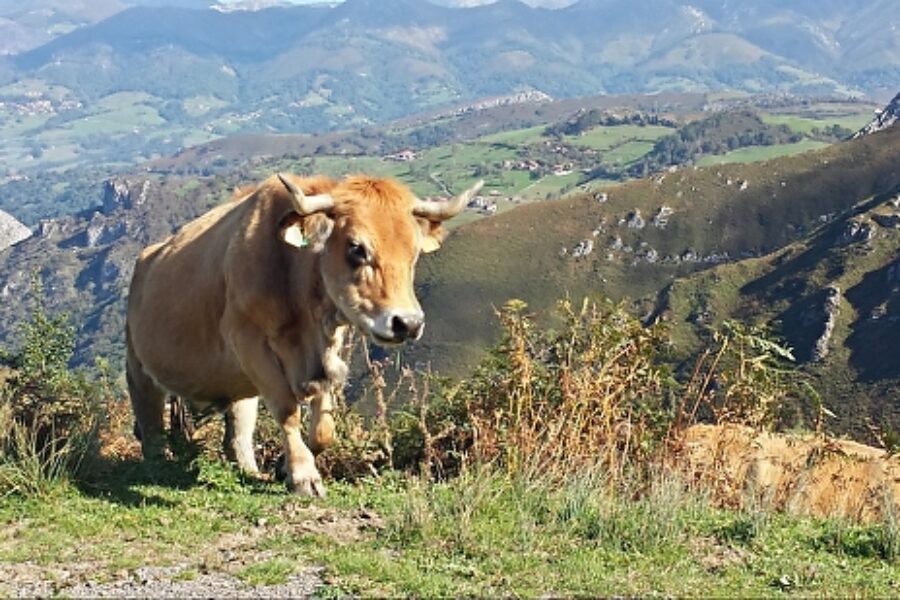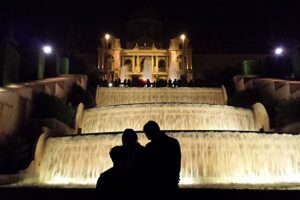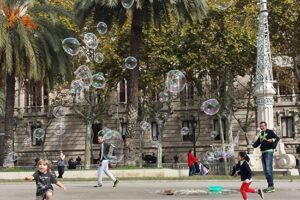Getting There
In the car, out of the parking garage, on the verge of a day’s adventure I want to show Michael the map. He’ll have none of it. “Just tell me which way to go,” he says, “but first I need to buy fuel.”
My plans are to see the Roman bridge in Cangas de Onis, the basilica in Covadonga, take the twisty turning AS115 through the foothills, turn right toward Llane, see the lighthouse, have lunch and meander back to Ribadesella, investigating the nooks and crannies of the Austurian coast along the way. I like my plan.
“Follow the signs to Covadonga,” I tell him.

I have been dreaming of seeing this huge basilica hanging from a cliff, skimming the treetops, ever since stumbling upon it in my guidebook. It looks like a magic castle and I can’t wait to just be there; on its doorstep, within its lofty heights. The drive takes barely an hour. The road is almost totally ours and I ask Michael to stop so I can take a picture of low clouds drifting through the rural valley.
“I wish I could get rid of the wires,” I say.
“That’s Spain,” he replies.
I could paint the scene…and leave out the wires. Cut down that tree.
We pass a group of parked tour buses; the drivers stand in a tight knot, talking. The former occupants form a long parade, carrying placards, walking along the edge of the road.
Covadonga

I look up and see a delicate spire towering far above me. We’re here. I think we should hurry. I worry about potential protests, but then I think again… What could they possibly want to protest?
There is no way to hurry. We climb higher, rounding a curve. Cars are parked everywhere; people spilling out of their vehicles and onto the winding road. A bride, standing in the dirt, straightens her billowing white gown with one hand, while the other holds a bouquet of flowers high above her head.
To our left, embedded in the face of the rocky cliff is a cave. The cave — full of pews. The pews — full of people. I have read that this is a chapel, the site of Pelayo’s tomb. Pelayo, ruler of the Visigoths, leader of the Asturian people in the first successful battle, fought in 722, against the Moors. I also remember reading that crowds of pilgrims come to visit the cave where he is buried.
We wind our way to the top of the hill, the church in the treetops, and the center of the town, only to be turned away by the army and the police. Throngs of people crowd the streets. “Now what?” Michael asks.
When I tell him, he shakes his head and calls me a quitter. I think I am cutting my losses and — adjusting. We wind our way back down the mountain road, following cars, leading cars — passing oncoming cars. Turning right, heading for the Mirador de la Reina — we climb. Not alone, there are cyclists everywhere.
Picos de Europa
As we ascend other cars descend. We follow even more cars, and more cars follow us. It is Saturday. The weather is more than perfect. Of course, all of Spain is on this mountain.
Climbing a very steep grade, on our left a sheer rocky slope reaches skyward. Three cows grazing above us appear to be standing on the backs of one another. How can they not tumble down?
“Watch out for falling cows.” I can’t help myself.
Up ahead I see a small clearing where other cars have pulled off the road. We do the same. I open the door, stepping out, and smell my grandmother’s farm. Michael points to the ground and advises I watch where I walk. I step gingerly.

Knowing that hiking the interior of the Picos de Europa was not a possibility, my desire of seeing them this entire trip has not abated. Hoping beyond hope to at least see the fringe, I was afraid they were lost to me. Yet here I am. Their magnificence and grandeur spread before me in all their glorious wonder. The cars, the cows, the cyclists — they were worth every heart-stopping moment to get here.
The cows bring me back to the present; the bells around their necks create music with every step. They take it for granted, this world of theirs. Crossing the road, they lumber and plod — causing a slanted traffic jam — and they don’t care.


Capturing the Moment
I snap picture after picture. Looking at what I captured with the camera’s eye, I want to delete each one. They are no good. They capture nothing. The greens before me are so intense. So bright. So deep. Verdant.
My phone shows me nothing but mud. How can it capture mud when the view before me is so grand?
I want to remember these greens; the shades of phthalo, Prussian and forest, and the deep purple shadows hiding in the valleys and between the rocks. If I paint a picture the way it really looks, people will think it is fake.
Come, stand beside me, I think. Inhale the greenness of the lush fertile valleys and the mountain peaks that touch the sky. Love the cows that make it all real.

AS114 to San Vicente de la Barquera
We follow the cattle back down the mountain. Checking the map I see that I can extend our trip through the feet of the Picos de Europa — if not having access to their heart — by following the AS114 through the mountains, toward the sea. It will take longer, we will leave Llanes far behind, but Michael doesn’t really know the plan, and Michelin says it is scenic.
“Tell me which way to go.”
“Follow the AS114 to San Vicente de la Barquera,” I say, estimating that we will still be able to make it to LLanes by two, perhaps three, for lunch.




The passage is slow — and worth every extra minute of being here.

As we cross the bridge toward the sea and away from San Vicente’s city center, looking for the lighthouse my map assures me is here, Michael says he is ready for lunch. He stops in front of a rectangular, squat and utilitarian brick building with absolutely no charm. He parks the car. We cross the street and climb the steps. Everyone is in the bar, talking, laughing, drinking. The first to arrive in the white-clothed, flower-bedecked dining area, we ask for an outside table. A shake of the waiters head, a shrug of his shoulders, and his hand pointing to small placards at each table, tells us each one is reserved.

We are seated next to a wall of windows near an open door. Lunch is long and luscious and lingering.

Pimiango
It is well beyond four when we push ourselves away from the table. After a short walk we continue our journey, looking for another lighthouse, this one slightly north of a small village called Pimiango.
The path we take leads us up a mountain, through an array of narrow streets and into a valley — to a locked gate. Michael creatively turns the car around and drives to a mirador we saw along the way. Stopping. Walking. Climbing. Sitting. Staring at the sea.





On our way back through the tiny village of Pimiango we see what appears to be a lost soul. If not a Texas Longhorn, then this guy is a close cousin. I put my phone and Google to work and find that the longhorn evolved from Iberian cattle brought to America by the Spanish in the late 1400’s. I feel I found a friend from home — albeit an unhappy looking friend.




In Llanes we get lost in a maze of ancient buildings, one-way streets, and too many tourists. The lighthouse is in old-town, but we don’t seem to be able to get there from where we are.
The Way to Ribadesella
We head for the peaceful beauty, the scent of the sea, and the crashing surf of Ribadesella — only to be barred from the gates.

The single one-way road leading to our hotel is blocked off, guarded by the police. We along with other cars are pointed in the opposite direction of where we need to be. I thought marathons were run in the morning. If so, these runners have been running a long, long time.
We drive east along the back roads, poking in corners. Turning back the way we came, we head for the city center. Arriving, we are forced to keep driving.
On the road west, we find a beachy restaurant where I would love to have lunch. We return to the city center.
Taking yet another road, we explore more small villages.
An hour later we sit in the crowded bar of our hotel. I order a Bombay Sapphire martini. Here they fix it with olives…and a twist.









Leave a Reply
Your email is safe with us.